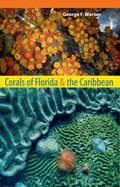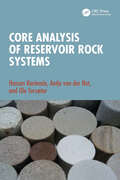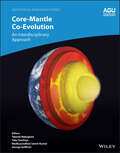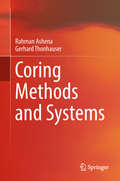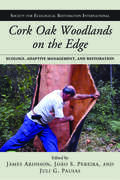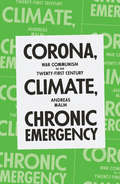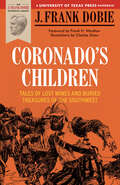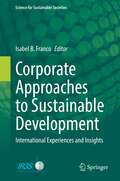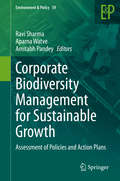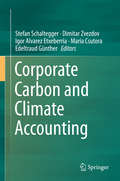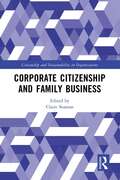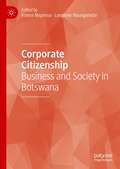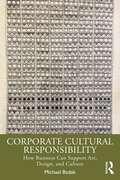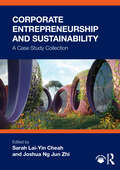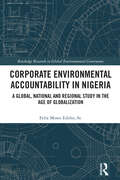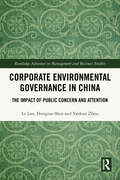- Table View
- List View
Corals (Nature's Children)
by Rob HoustonDescribes the physical characteristics, habits, and natural environment of corals.
Corals of Florida and the Caribbean
by George F. WarnerPresenting a stunning array of beauty and biodiversity, the coral reefs of Florida and the Caribbean are part playground, part research lab for the thousands of tourists, divers, and marine scientists who visit them every year. Documenting the wide array of corals at home in the warm waters of the Caribbean, George Warner's Corals of Florida and the Caribbean provides an easy-to-use (and carry) guidebook that is both scientifically accurate and reader friendly.Warner provides an exhaustive identification guide that will enrich any novice's vacation dive or an expert's return to the reefs. Written for the amateur naturalist, this handbook will travel well throughout the Caribbean, from Florida south to Belize, east to Tobago, and all points in between.Beyond documenting the wide variety of corals found in the Caribbean, Warner also outlines their biology, from the way they grow to their reproductive habits, while examining major threats to the reefs including hurricanes, pollution, and global warming. With over 150 color photos, most taken by the author himself, as well as detailed descriptions, Corals of Florida and the Caribbean makes identifying and learning about corals hassle free--on the boat, at home, or in the classroom.
Cordwood Building
by Rob RoyCordwood masonry is an ancient building technique whereby walls are constructed from "log ends" laid transversely in the wall. It is easy, economical, aesthetically striking, energy-efficient, and environmentally sound.Cordwood Building collects the wisdom of more than 25 of the world's best practitioners, detailing the long history of the method, and demonstrating how to build a cordwood home using the latest and most up-to-date techniques, with a special focus on building code issues.Author/editor Rob Roy has been building, researching, and teaching about cordwood masonry for 25 years and, with his wife, started Earthwood Building School in 1981. He has written 10 books on alternative building, presented four videos--including two about cordwood masonry--and has taught cordwood masonry all over the world.
Core Analysis of Reservoir Rock Systems
by Hassan Karimaie Antje van der Net Ole TorsæterCore analysis is an essential source of quantitative data on reservoir properties. These data are used for modeling the distribution and flow of oil and gas reservoirs, CO2 and hydrogen storage, and flow behavior in geothermal reservoirs. While several books cover core analysis for practitioners, this book fills a gap through introducing laboratory equipment and procedures used in core analysis and the theoretical aspects of the parameters. It offers detailed instructions on experimental execution for those with limited or no experience including risk analysis for high safety. Emphasizes the basic characterization of porous materials for multiphase flow, specifically consolidated natural materials Features methods commonly used in the special core analysis within the oil and gas industry, extending to the emerging field of gas storage with occasional references to research-oriented equipment Offers detailed descriptions of laboratory exercises and instructions on data analysis suitable for student work Includes solutions to some exercises to demonstrate the application of measured parameters in reservoir evaluation Provides a unique combination of brief discussions on the basic theory of parameters, explanations of experimental principles, detailed experimental procedures according laboratory standards, and data analysis, with multiple laboratory-related example problems This concise and practical workbook is written for everyone interested in practical measurements of parameters needed for analysis of fluid flow in porous media, specifically students, or for starting staff in the laboratory, preferably with a background in geosciences or fluid mechanics or related topics.
Core Electrodynamics (Undergraduate Lecture Notes in Physics)
by Sandra ChapmanThis book is intended to engage the students in the elegance of electrodynamics and special relativity, whilst giving them the tools to begin graduate study. Here, from the basis of experiment, the authors first derive the Maxwell equations and special relativity. Introducing the mathematical framework of generalized tensors, the laws of mechanics, Lorentz force and the Maxwell equations are then cast in manifestly covariant form. This provides the basis for graduate study in field theory, high energy astrophysics, general relativity and quantum electrodynamics. As the title suggests, this book is “electrodynamics lite”. The journey through electrodynamics is kept as brief as possible, with minimal diversion into details, so that the elegance of the theory can be appreciated in a holistic way. It is written in an informal style and has few prerequisites; the derivation of the Maxwell equations and their consequences is dealt with in the first chapter. Chapter 2 is devoted to conservation equations in tensor formulation; here, Cartesian tensors are introduced. Special relativity and its consequences for electrodynamics are introduced in Chapter 3 and cast in four-vector form, and here, the authors introduce generalized tensors. Finally, in Chapter 4, Lorentz frame invariant electrodynamics is developed. Supplementary material and examples are provided by the two sets of problems. The first is revision of undergraduate electromagnetism, to expand on the material in the first chapter. The second is more advanced corresponding to the remaining chapters, and its purpose is twofold: to expand on points that are important, but not essential, to derivation of manifestly covariant electrodynamics, and to provide examples of manipulation of cartesian and generalized tensors. As these problems introduce material not covered in the text, they are accompanied by full worked solutions. The philosophy here is to facilitate learning by problem solving, as well as by studying the text. Extensive appendices for vector relations, unit conversion and so forth are given with graduate study in mind.
Core Samples: A Climate Scientist's Experiments in Politics and Motherhood
by Anna Farro HendersonPeople live by their stories—how can we use them to accelerate action on climate change? Climate scientist and policy expert Anna Farro Henderson embarks on a remarkable narrative journey in Core Samples, exploring how science is done, discussed, legislated, and imagined. Through stories both raucous and poignant—of far-flung expeditions, finding artistic inspiration in research, and traversing the systemic barriers women and mothers face in science and politics—she brings readers into the daily rhythms and intimacies of scientific research and political negotiation. Grounded in her experiences as a climate scientist, an environmental policy advisor to Minnesota Senator Al Franken and Governor Mark Dayton, and a constant juggler of the many roles and responsibilities of professional moms, Henderson&’s eclectic, unconventional essays range from observations, confessions, and meditations on lab and fieldwork to a packing list for a trip to the State Capitol and a lactation diary. Readers are invited on voyages as far afield as the Trinity nuclear test site in New Mexico, the Juneau Icefield in Alaska, and a meteor crater in Ghana—and as close to home as a town hall meeting in America&’s corn belt. A love letter to science and a bracing (and sometimes hilarious) portrait of the many obstacles women, mothers, and people digging for truth navigate, Core Samples illuminates the messy, contradictory humanity of our scientific and political institutions. Bringing us behind the closed doors of discovery and debate, Henderson exposes the flaws in research institutions, the halls of government, and the role of science in policy, yet she shows how each crack is also an invitation for camaraderie, creativity, and change.
Core-Mantle Co-Evolution: An Interdisciplinary Approach (Geophysical Monograph Series)
by George Helffrich Takashi Nakagawa Taku Tsuchiya Madhusoodhan Satish‐KumarCore-Mantle Co-Evolution An Interdisciplinary Approach The Earth’s deep interior is difficult to study directly but recent technological advances have enabled new observations, experiments, analysis, and simulations to better understand deep Earth processes. Core-Mantle Co-Evolution: An Interdisciplinary Approach seeks to address some of the major unsolved issues around the core-mantle interaction and co-evolution. It provides the latest insights into dynamics, structure, and evolution in the core-mantle boundary region. Volume highlights include: Latest technological advances in high pressure experiments and their application to understanding the mineral physical properties and stability of phases in deep Earth Recent progress in observational seismology, geochemical analysis, geoneutrino experiments, and numerical modeling for understanding the heterogeneity of the lower mantle Theoretical investigations on thermal-chemical evolution of Earth’s mantle and core Exploring thermal-chemical-mechanical-electromagnetic interactions in the core-mantle boundary regions The American Geophysical Union promotes discovery in Earth and space science for the benefit of humanity. Its publications disseminate scientific knowledge and provide resources for researchers, students, and professionals.
Coring Methods and Systems
by Gerhard Thonhauser Rahman AshenaThis book is a practical guide to downhole rock sampling and coring concepts, methods, systems, and procedures for practitioners and researchers. Its chapters are based upon years of extensive studies and research about the coring methods and via direct and continuous communication and consultation obtained from various service and operator companies such as Baker Hughes GE, NOV, OMV, and Sandvik. The contributors discuss the state-of-the-art coring methods and systems (mainly used in the petroleum industry), which include: · conventional coring; · wireline continuous coring; · invasion mitigation coring (low invasion, gel coring, sponge coring); · jam-detection, anti-jamming, full closure; · safe-coring and tripping; · oriented-coring; · pressure/in-situ coring; · logging-while-coring; · motor coring; · mini-coring; · coiled Tubing Coring; and · underbalanced coring. The contributors provide practical and applicable understanding of the procedures of these coring methods and systems, as well as the specific core barrel components, working mechanisms, and schematics of the tools and processes used. Because Coring Methods and Systems analyses and compares the core barrels used in both petroleum and mining industries, it enhances the communication and may allow knowledge transfer between the two industries. As core damage is a serious issue during coring and handling jeopardizing correct calibration of exploration data, Coring Methods and Systems has greatly focused on its identification and its mitigation. Therefore, it can be used as an ideal source for geologists, core analysts, and reservoir engineers, to ensure the retrieval of high-quality cores.
Cork Oak Woodlands on the Edge: Ecology, Adaptive Management, and Restoration (Science Practice Ecological Restoration)
by Juli G. Pausas James Aronson João Santos PereiraCork oak has historically been an important species in the western Mediterranean--ecologically as a canopy or "framework" tree in natural woodlands, and culturally as an economically valuable resource that underpins local economies. Both the natural woodlands and the derived cultural systems are experiencing rapid change, and whether or not they are resilient enough to adapt to that change is an open question. Cork Oak Woodlands on the Edge provides a synthesis of the most up-to-date, scientific, and practical information on the management of cork oak woodlands and the cultural systems that depend on cork oak. In addition, Cork Oak Woodlands on the Edge offers ten site profiles written by local experts that present an in-depth vision of cork oak woodlands across a range of biophysical, historical, and cultural contexts, with sixteen pages of full-color photos that illustrate the tree, agro-silvopastoral systems, products, resident biodiversity, and more. Cork Oak Woodlands on the Edge is an important book for anyone interested in the future of cork oak woodlands, or in the management of cultural landscapes and their associated land-use systems. In a changing world full of risks and surprises, it represents an excellent example of a multidisciplinary and holistic approach to studying, managing, and restoring an ecosystem, and will serve as a guide for other studies of this kind.
Cornish Clouds and Silver Lining Skies: Your no. 1 sunny, feel-good read for the summer
by Ali McNamaraMeteorologist Sky Matthews does not like surprises.Sky monitors her life like she does the weather, carefully and with a scientific eye. So, when she misses out on her dream job abroad and finds herself with no choice but to take a position on a tidal island off the Cornish harbour town of St Felix instead, she feels completely at sea. Worse still, she has to work alongside TV weatherman Sonny Samuels, who barely knows his storms from his tsunamis.It doesn't take long for Sky to become enchanted by the strange weather patterns over St Felix. Sonny is convinced they link to local folklore, but Sky knows her science too well to fall for that. Until she meets Walter, a local weather watcher with no qualifications beyond a lifetime of experience and Sky is forced to question everything she thought she knew about the weather, herself... and Sonny._______________Praise for Ali McNamara:An enchanting escape. Pure magic!' Heidi Swain'A perfect, sparkling, summer read.' Cathy Bramley'Fun and endearing' Katie Fforde'Perfect easy reading' SunAn irresistible, feel-good story infused with infectious humour' Miranda Dickinson'Funny and light-hearted' Heat
Cornish Clouds and Silver Lining Skies: Your no. 1 sunny, feel-good read for the summer
by Ali McNamaraMeteorologist Sky Matthews does not like surprises.Sky monitors her life like she does the weather, carefully and with a scientific eye. So, when she misses out on her dream job abroad and finds herself with no choice but to take a position on a tidal island off the Cornish harbour town of St Felix instead, she feels completely at sea. Worse still, she has to work alongside TV weatherman Sonny Samuels, who barely knows his storms from his tsunamis.It doesn't take long for Sky to become enchanted by the strange weather patterns over St Felix. Sonny is convinced they link to local folklore, but Sky knows her science too well to fall for that. Until she meets Walter, a local weather watcher with no qualifications beyond a lifetime of experience and Sky is forced to question everything she thought she knew about the weather, herself... and Sonny._______________Praise for Ali McNamara:An enchanting escape. Pure magic!' Heidi Swain'A perfect, sparkling, summer read.' Cathy Bramley'Fun and endearing' Katie Fforde'Perfect easy reading' SunAn irresistible, feel-good story infused with infectious humour' Miranda Dickinson'Funny and light-hearted' Heat
Cornish Clouds and Silver Lining Skies: Your no. 1 sunny, feel-good read for the summer
by Ali McNamaraMeteorologist Sky Matthews does not like surprises.Sky monitors her life like she does the weather, carefully and with a scientific eye. So, when she misses out on her dream job abroad and finds herself with no choice but to take a position on a tidal island off the Cornish harbour town of St Felix instead, she feels completely at sea. Worse still, she has to work alongside TV weatherman Sonny Samuels, who barely knows his storms from his tsunamis.It doesn't take long for Sky to become enchanted by the strange weather patterns over St Felix. Sonny is convinced they link to local folklore, but Sky knows her science too well to fall for that. Until she meets Walter, a local weather watcher with no qualifications beyond a lifetime of experience and Sky is forced to question everything she thought she knew about the weather, herself... and Sonny._______________Praise for Ali McNamara:An enchanting escape. Pure magic!' Heidi Swain'A perfect, sparkling, summer read.' Cathy Bramley'Fun and endearing' Katie Fforde'Perfect easy reading' SunAn irresistible, feel-good story infused with infectious humour' Miranda Dickinson'Funny and light-hearted' Heat
Corona, Climate, Chronic Emergency: War Communism in the Twenty-First Century
by Andreas MalmWhat does the COVID 19 tell us about the climate breakdown, and what should we do about it?The economic and social impact of the coronavirus pandemic has been unprecedented. Governments have spoken of being at war and find themselves forced to seek new powers in order to maintain social order and prevent the spread of the virus. This is often exercised with the notion that we will return to normal as soon as we can. What if that is not possible? Secondly, if the state can mobilize itself in the face of an invisible foe like this pandemic, it should also be able to confront visible dangers such as climate destruction with equal force. In Corona, Climate, Chronic Emergency, leading environmental thinker, Andreas Malm demands that this war-footing state should be applied on a permanent basis to the ongoing climate front line. He offers proposals on how the climate movement should use this present emergency to make that case. There can be no excuse for inaction any longer.
Coronado's Children: Tales of Lost Mines and Buried Treasures of the Southwest (Barker Texas History Center Series)
by J. Frank DobieWritten in 1930, Coronado's Children was one of J. Frank Dobie's first books, and the one that helped gain him national prominence as a folklorist. In it, he recounts the tales and legends of those hardy souls who searched for buried treasure in the Southwest following in the footsteps of that earlier gold seeker, the Spaniard Coronado. "These people," Dobie writes in his introduction, "no matter what language they speak, are truly Coronado's inheritors. . . . l have called them Coronado's children. They follow Spanish trails, buffalo trails, cow trails, they dig where there are no trails; but oftener than they dig or prospect they just sit and tell stories of lost mines, of buried bullion by the jack load. . . " This is the tale-spinning Dobie at his best, dealing with subjects as irresistible as ghost stories and haunted houses.
Coronavirus: La covid-19 explicada a los niños
by Ben Matynoga¿Cómo un virus tan pequeño y frágil ha logrado cambiar el mundo? Coronavirus, el libro ilustrado que explica a los niños todo lo que deben saber sobre la covid-19. Escrita por el científico Ben Martynoga. ¿De dónde viene? ¿Cómo se propaga? ¿Podemos vencerlo? El coronavirus es 15.000 veces más pequeño que una pulga y podemos matarlo con una pastilla de jabón. ¿Cómo un virus pequeño y frágil cambió el mundo? Sumérgete en el fascinante mundo de los virus junto al científico Ben Martynoga y descubrirás cosas divertidas y a la vez aterradoras de la pandemia que ha cambiado el mundo. Una fascinante historia sobre cómo las células humanas han sido secuestradas por un virus y sobre cómo nuestro cuerpo responde. En el camino, aprenderás qué son los virus, cómo funcionan y cómo podemos vencerlos, o al menos, aprender a convivir con ellos.
Corporate Approaches to Sustainable Development: International Experiences and Insights (Science for Sustainable Societies)
by Isabel B. FrancoThis book aims to answer the question: how can the industry action international approaches to corporate sustainability, ultimately achieving sustainable development and overall sustainability? With this question in mind, this manuscript examines how the industry, through existing approaches to corporate sustainability, contribute to addressing conflicting demands emerging from the achievement of sustainable development in a responsible, sustainable and innovative manner. It also reviews alternative models of corporate sustainability that contribute to achieving inclusive, sustainable development globally. Chapters 2 to 4 discuss emerging approaches to corporate sustainability. Chapters 5 to 11 examine the role that the extractive industry (mining and oil) could play in the delivery of sustainable solutions for the communities and environment in selected cases, in the Americas and Africa. Lastly, the manuscript showcases international corporate sustainability and climate change practices in the forestry, agriculture, tourism and manufacturing industries within the context of Asia and The Pacific region, particularly, Nepal and Bangladesh.
Corporate Biodiversity Management for Sustainable Growth: Assessment of Policies and Action Plans (Environment & Policy #59)
by Amitabh Pandey Ravi Sharma Aparna WatveThis book aims to cover the multitude of corporate approaches towards mainstreaming biodiversity conservation and ecological management in policies and action plans, and explores the roles of these efforts in achieving national and global targets for the Sustainable Development Goals (SDGs). The book addresses various aspects of corporate actions such as corporate environmental responsibility, green businesses, market-based approaches to biodiversity conservation, and biodiversity trade-offs, and includes concept papers, reviews, and case studies presenting qualitative and quantitative research. Additionally, the text compares and assesses examples of positive and negative impacts of corporate involvement in biodiversity conservation in developed and developing countries to identify innovative approaches, and the best practices and models that can be replicated in diverse environmental conditions. The studies included in the book will help those working in the field of corporate involvement in biodiversity conservation, and outline the strengths and weaknesses of the approaches which will be useful for designing new environmental management action plans in the face of climate change. The book will also be of great value to researchers, academicians, policy makers, civil society groups, policy think tanks, and conservation managers.
Corporate Carbon and Climate Accounting
by Stefan Schaltegger Dimitar Zvezdov Igor Alvarez Etxeberria Maria Csutora Edeltraud GüntherThis volume is devoted to management accounting approaches for analyzing business benefits and costs of climate change. It discusses future directions on carbon accounting, performance measurement and reporting as well as links between climate accounting and business processes, product and service development, supply chain innovation, economic successes and stakeholder relations. Companies are increasingly called on to contribute to combatting climate change and also face the challenges presented by climate-change related costs, risks and benefits. Risks can result from unpredictable weather conditions and government regulations, such as the EU emission trading system and new building codes. Climate change also offers numerous opportunities, such as energy efficiency innovations and carbon neutral products and production. Good management requires that carbon emissions are tracked and climate-related costs, risks and benefits are identified, measured and assessed. As such, research addressing corporate accounting frameworks and tools is of increasing importance when it comes to managing these carbon and climate-related issues.
Corporate Citizenship and Family Business (Citizenship and Sustainability in Organizations)
by Claire SeamanCurrent models of corporate citizenship largely consider business as one coherent entity. This view of business as a corporate force overlooks the growing evidence that most businesses are run by families. Family businesses are the most common form of business in existence – across countries, continents and geopolitical divides – and yet we know remarkably little about their approach to corporate citizenship. Where families run businesses, they create a concentration of family values that – for good or ill – influence the way business practices and behaviours develop. The role of the family in business has, therefore, an influence on the development of society that is partially mediated through corporate citizenship. This book pulls together current thinking from several diverse research fields that intersect with family business research to offer insight into current research and examples of practice for those studying and researching in the fields of family business, business values and corporate practice. The book will also explore the fact that family businesses tend to take a longer-term approach to business and that this is reflected in their behaviour towards the environment, community engagement, employee development and innovation. Bringing together contributions from researchers in the diverse fields of family business, philanthropy, community engagement, corporate social responsibility, innovation and policy, this book explores the many ways in which family businesses contribute to the corporate citizenship agenda.
Corporate Citizenship: Business and Society in Botswana
by France Maphosa Langtone MaunganidzeThis book discusses corporate citizenship, corporate responsibility and business ethics across Africa generally, and Botswana specifically. It begins by contextualizing Botswana within the broader context of Africa, using nine other countries – Angola, Cameroon, Ghana, Kenya, Nigeria, South Africa, Zambia and Zimbabwe – to provide a comparative perspective, examining the common factor: that weak legalization makes it challenging for corporate social responsibility to be actualized.From this background, the book then discusses Botswana as a key study. Botswana has been described as ‘Africa’s economic miracle’ due to its growing economy since independence This puts it in a unique position for the implementation and study of corporate social responsibility. The interdisciplinary team of authors employ various research methods to examine the complex relationship between business, society, corporations and social justice issues.This book will be valuable reading for any academic working on corporate social responsibility in Africa, and will present an interesting insight to an often neglected area of study. France Maphosa is a Professor of Sociology at the University of Botswana. His research interests include migration and transnationalism, the sociology of entrepreneurship, corporate social responsibility, urban and rural livelihoods, labour studies and alternative dispute resolution (ADR).Langtone Maunganidze is a Senior Lecturer in the Faculty of Social Sciences at the Midlands State University in Zimbabwe. His research interests include industrial sociology, business and society, rural livelihoods and sustainable development, and entrepreneurship.
Corporate Cultural Responsibility: How Business Can Support Art, Design, and Culture
by Michael BzdakIs corporate investing in the arts and culture within communities good business? Written by an expert on the topic who ran the Corporate Art Program at Johnson & Johnson, the book sets out the case for business patronage of the arts and culture and demonstrates how to build an effective program for businesses to follow. As companies seek new ways to add value to society, this book places business support of the arts in a corporate social responsibility context and offers a new concept: Corporate Cultural Responsibility. It discusses the issues underlying business support of the arts and explores new avenues of collaboration and value creation. The framework presented in the book serves as a guide for identifying the key attributes and projected impact of successful and sustainable models. Unlike other books centered on the relationship of art and commerce, this book looks at the broader and global implications of Corporate Cultural Responsibility. It also usefully sets the discussion about the role of philanthropy and corporate social responsibility and the arts within an historical timeframe. As the first book to link culture to community responsibility, the book will be of particular relevance to corporate art advisors and auction houses, as well as students of arts management and corporate social responsibility at advanced undergraduate and postgraduate levels.
Corporate Entrepreneurship and Sustainability: A Case Study Collection
by Sarah Lai-Yin Cheah Joshua Ng Jun ZhiThis book provides detailed case studies exploring how industry-leading organizations are integrating corporate innovation and sustainability initiatives.The book first introduces the difficulties and importance of managing innovation within established organizations. It identifies five themes key for organizations seeking to future-proof their business: external drivers in the business environment, structures for corporate entrepreneurship, modes of collaboration, sustainability as a lever for innovation, and performance management. It then provides detailed case studies of how companies across diverse sectors, such as banking, shipping, and real estate, made the choice between short-term profit and future-proofing their business. Cases are written such that they can be used independently, and a storytelling approach is used so that readers may apply the conceptual frameworks and see how theories are translated into practice. Detailed teaching notes are available for instructors, each containing a sample lesson plan, six discussion questions, suggested answers, and further readings.A useful teaching resource for instructors and students in corporate entrepreneurship, corporate innovation, and strategic foresight.
Corporate Environmental Accountability in Nigeria: A Global, National and Regional Study in the Age of Globalization (Routledge Research in Global Environmental Governance)
by Felix Moses EdohoThis book examines the imperative role of global environmental governance, and the need to incorporate corporate environmental accountability and mechanisms for enforcement, to effectively address the global environmental crisis. The author, Felix Moses Edoho, Sr., examines the issues at the various global, national, and regional levels. In Part I the book examines the issues at the global level and looks at the impact of transnational corporations (TNCs) and globalization on the global environmental crisis. Furthermore, it also examines the efforts of the United Nations in initiating global environmental architecture to tackle the crisis. Part II considers the issues at the national level and focuses on Nigeria. The author explores Nigeria’s regulatory and institutional framework for environmental governance and implementation. Lastly, at the regional level in Part III, the discourse centers on how decades of oil exploration and production have unleashed monumental ecological tragedies in the Niger Delta region of Nigeria due to the lack of corporate environmental accountability. This book will be of great interest to academics and students who are interested in broadening their knowledge of environmental governance and policy in developing countries. It will also be of value to environmental regulatory agencies and public administrators, development professionals, and TNCs.
Corporate Environmental Accountability in Nigeria: A Global, National and Regional Study in the Age of Globalization (Routledge Research in Global Environmental Governance)
by Felix Moses EdohoThis book examines the imperative role of global environmental governance, and the need to incorporate corporate environmental accountability and mechanisms for enforcement, to effectively address the global environmental crisis.The author, Felix Moses Edoho, Sr., examines the issues at the various global, national, and regional levels. In Part I the book examines the issues at the global level and looks at the impact of transnational corporations (TNCs) and globalization on the global environmental crisis. Furthermore, it also examines the efforts of the United Nations in initiating global environmental architecture to tackle the crisis. Part II considers the issues at the national level and focuses on Nigeria. The author explores Nigeria’s regulatory and institutional framework for environmental governance and implementation. Lastly, at the regional level in Part III, the discourse centers on how decades of oil exploration and production have unleashed monumental ecological tragedies in the Niger Delta region of Nigeria due to the lack of corporate environmental accountability.This book will be of great interest to academics and students who are interested in broadening their knowledge of environmental governance and policy in developing countries. It will also be of value to environmental regulatory agencies and public administrators, development professionals, and TNCs.
Corporate Environmental Governance in China: The Impact of Public Concern and Attention (Routledge Advances in Management and Business Studies)
by Le Luo Hongtao Shen Yankun ZhouThe book explores how diverse stakeholder groups—particularly community and regulatory stakeholders—shape corporate environmental practices. Focusing on one of the world’s largest economies, this book provides an in-depth analysis of stakeholder dynamics and their impact on corporate environmental performance and disclosure.Environmental governance has become a global imperative as environmental crises intensify and stakeholder expectations grow. The book examines the interplay between community advocacy and regulatory actions and particularly focuses on how community stakeholders drive corporate accountability by pressuring regulatory authorities to enforce stricter measures or provide financial incentives. The chapters include discussions on the role of public environmental awareness and concern in shaping corporate performance and disclosure practices. The book also highlights how regulatory influence mediates the relationship between community influence and corporate environmental outcomes, offering new insights into the interactive dynamics of stakeholder influence.This book will be of interest to policymakers, corporate managers, and academics seeking to understand the nuanced relationships between businesses, governments, and communities. It offers actionable recommendations for fostering effective environmental governance and sustainable corporate practices.

